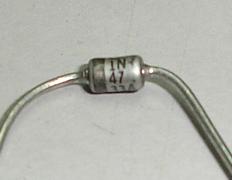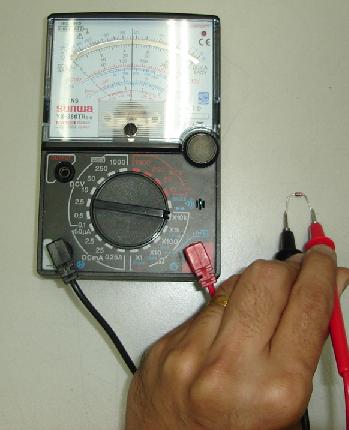Testing Zener Diode The Accurate Way
Method of testing zener diode is totally different from testing diode. You need an analog meter to do the job. Before you start to test any zener diode, you must first understand the marking or part number and then look for the voltage ratings. Refer to my article about how to read the zener diode data. Once you know the zener diode voltage from your favorite data book such as the Philip ECG semiconductor master replacement guide then it is easy to check with your meter to see if it leak, open or shorted.
Sometimes a normal signal glass type diode you may think is a zener diode thus you will not get the exact measurement. If you have confirmed that the diode you want to measure is zener diode then you can proceed to use my method to accurately test it. For your knowledge, a zener diode with 2.4 volt to 12 volt should have two readings when test with an analog meter set to times 10K ohm range. But these readings are not shorted reading!
A 1N4733A zener diode
Let me guide you, when you put your meter probes across the zener diode of 2.4 volt using the times 10 k ohm range, one way will show a full scale reading (red probe to cathode and black probe to anode) which mean the pointer will point towards the 0 ohms scale, if you now connect the probe the other way (black probe to cathode and red probe to anode) the pointer will point to around 2- 4 ohms!
If both ways of testing cause the pointer to point to 0 ohm, then the zener diode is considered shorted. When you measure a 5.1 volt zener diode, as usual one way will point to zero ohms while the other way will show a higher resistance which is in the 20 to 60 ohms. These are the characteristic of a good working zener diode and don’t think that the meter shows two reading means the zener diode is faulty.
If you get two reading when you measure a normal diode, then the diode is shorted. As I mentioned above, testing zener diode is totally different from checking a normal diode.
When you connect your probe and measure a 13 volt zener diode and above voltage, it should show only one reading using the times 10 K ohms range. That's mean when you are touching the red probe to the cathode and black probe to the anode. Reversing the probe should not show any reading. If the result shows two readings then the zener diode is confirmed to be shorted or have developed a leakage. Start measuring zener diode taken out from your component's rack or from scraped electronic board, compare a good zener diode and a shorted one and see for yourself.
Write it down in your book what are the results that you get when comparing and checking a good and a bad zener diode. It would not take you a long time to become familiar in testing a zener diode accurately. One more tip, replace only a zener diode with the same or higher wattage. If possible use the exact voltage and watt if you want the equipment that you repair to last longer.
Use analog multimeter to test zener diode
|
|
Copyright@ 2006-2014-www.ElectronicRepairGuide.com All Rights Reserved

